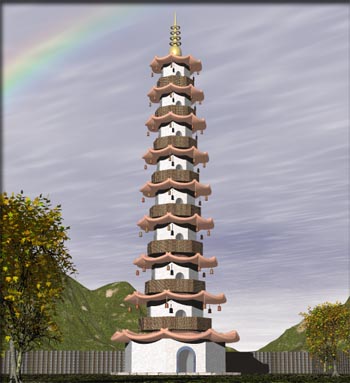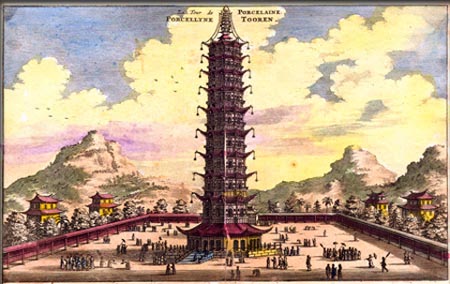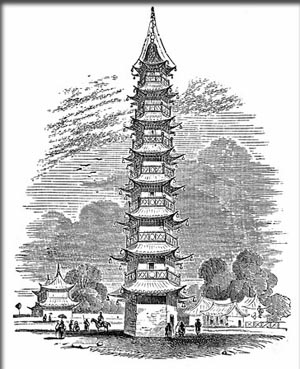|

The
tower at Nanjing was considered to be one of the most
beautiful temple towers in all of China.  (Copyright Lee Krystek, 2012)
(Copyright Lee Krystek, 2012)
|
|
|
|
The
Tower of Nanjing: The Lost Porcelain Pagoda
|
"The
best contrived and noblest structure of all the East," the French
mathematician, Le Comte, said when he saw it. Its "many-coloured
tiles and bricks were highly glazed, giving the building a gay
and beautiful appearance," wrote an enamored American missionary.
Both of these 19th century visitors to China were referring
to the astonishing Tower of Najing, a wondrous temple that today
is gone.
Construction
of the Bao'ensi, or "Temple of Gratitude," started in the early
15th century. The Ming Dynasty's Yongle emperor ordered its
erection in his capital city of Nanjing which sits on the south
bank of the mighty Yangtze River. It is unclear to scholars
today if the emperor built the temple to honor both his parents
or just his mother. They do know that its construction took
seven years. The tower rose from an octagonal base 97 feet (30m)
wide and consisted of nine stories with a total height of 260
feet (97m). One visitor reported that there had once been plans
to extend the height to 330 feet (101m) by adding four more
stories, but they were
never realized.
|
Seven
Quick Facts
|
| Name:
Bao'ensi which means "Temple of Gratitude." |
| Height:
260 feet (97m) |
| Width:
97 feet (30m) at the octagonal base. |
| Construction:
Early in the 15th century. |
| Destruction:
1856, blown up by Taiping Rebels. |
| Made
of: Porcelain bricks and tiles with carved wood trim. |
| Other:
Served as a Buddhist Temple. |
Though
the tower was not the tallest pagoda constructed in China, it
was widely considered the most beautiful. Rather than being
constructed of only wood, the walls of the temple were made
of white porcelain bricks that must have glittered in the sunlight.
Worked into the porcelain of the walls was a mixture of green,
yellow, brown and white glazes in the design of animals, flowers,
bamboo, landscapes and Buddhist images.
Design
A visitor
climbing the tower would enter the temple through a decorative
archway into an octagonal-shaped room illuminated by a dozen
oil-burning porcelain lamps. From there he could climb the 190
steps of the spiral staircase through each of temple's levels.
As he walked upward, the visitor would pass niches containing
Buddhist statues. At each of the tower's progressively narrower
stories he would see lanterns and bells hung. One visitor counted
152 bells tinkling in the wind and 140 lamps illuminating the
temple at night. Another reported that the woodwork in the temple
was "strong, curiously carved and richly painted." At the top
the visitor would see a pole running vertically through the
final story. As the pole emerged from the roof it turned into
a spire. The spire was surrounded by iron rings set above a
sphere carved into the shape of a pineapple.
|

17th
Century Copperplate Engraving of the Tower.
|
The
tower quickly became an icon for the city and visitors from
the West reported on its beauty when they returned to their
homelands. A number of pagoda towers were built in Europe, including
one in the Kew Gardens of London, probably inspired by the porcelain
tower. Even today, the Victoria and Albert Museum in London
houses a 9-foot-high miniature of a pagoda tower thought to
be a replica of the one at Nanjing.
Destruction
Unfortunately,
the tower did not survive the 19th century. In 1801 a bolt of
lightning hit the tower, destroying the top three stories. These
were quickly rebuilt, but in 1853 Taiping Rebels took control
of the city. The rebels were Christians and destroyed much of
the Buddhist art in the temple along with the interior staircase.
The tower was still standing in May of 1854, however, when American
sailors visited the city and saw it. It is believed that in
1856 the rebels finally destroyed the tower completely, either
to deny its use as an observation post to their enemies or because
they had a superstitious fear of it.
|

Another
sketch of the tower.
|
The
tower only exists today in illustrations and museum miniatures.
However, in 2010, Wang Jianlin, a Chinese businessman, donated
one billion yuan ($156 million) to the city to have the temple
rebuilt. So the magnificent pagoda tower may someday once again
rise above the ancient city of Nanjing and reflect the morning
sun with its glittering porcelain walls.

Copyright Lee Krystek
2012. All Rights Reserved.